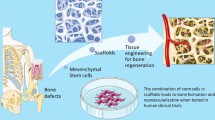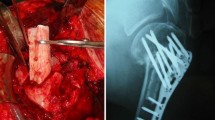Abstract
Purpose
The purpose of the present article was (1) to systematically review the current literature and (2) to collect data regarding the postoperative magnetic resonance imaging (MRI) appearance of third-generation autologous chondrocyte implantation (ACI) grafts and (3) to provide an overview of imaging findings at various postoperative time points.
Methods
A systematic review of the literature in Medline (Pubmed) and Embase was performed using the PRISMA (Preferred Reporting Items for Systematic Reviews and Meta-Analyses) guidelines. Articles which reported the post-operative MRI morphological outcomes following the use of third-generation ACI for treatment of knee cartilage lesions were included. All MRI results were allocated to six different time intervals: ≤ 3 months, > 3–6 months, > 6 months–1 year, > 1 year–2 years, > 2–5 years and > 5 years after surgery.
Results
A total of 22 studies were included and the study populations ranged from 13 to 180 patients adding up to a total of 951 patients. Parameters such as defect fill, border integration, surface contour, graft morphology and integrity of the subchondral lamina all improve gradually with a peak two years following surgery suggesting complete graft maturation at this time point. After this peak, a statistically insignificant decline is noted for most of the parameters. Signal intensity was found to gradually shift from hyperintense to isointense in the first 36 months and to hypointense later on. Contrarily, subchondral bone edema is not only a postoperative feature of the procedure but also can reappear or persist up to ten years after surgery. As graft failures can appear after two years, consequently, the MRI composite score is also affected.
Conclusion
Recurring patterns in postoperative MRI appearance were observed in certain parameters including defect filling, graft signal intensity and structure, border integration of the graft while parameters like subchondral bone tend to be unpredictable. Given the heterogenous findings in terms of clinical correlation, and relating that aspect to the patterns found in this review, an MRI is justified at three months, one year, two years and five years after surgery, unless the clinical symptomatology and individual patient needs dictate otherwise.
Level of evidence
IV.





Similar content being viewed by others
References
Aldrian S, Zak L, Wondrasch B, Albrecht C, Stelzeneder B, Binder H et al (2014) Clinical and radiological long-term outcomes after matrix-induced autologous chondrocyte transplantation: a prospective follow-up at a minimum of 10 years. Am J Sports Med 42(11):2680–2688
Anderson DE, Williams RJ, DeBerardino TM, Taylor DC, Benjamin C, Kane MS (2017) Magnetic resonance imaging characterization and clinical outcomes after NeoCart surgical therapy as a primary reparative treatment for knee cartilage injuries. Am J Sports Med 45(4):875–883
Blackman AJ, Smith MV, Flanigan DC, Mataya MJ, Wright RW, Brophy RH (2013) Correlation between magnetic resonance imaging and clinical outcomes after cartilage repair surgery in the knee a systematic review and meta-analysis. Am J Sports Med 41(6):1426–1434
Brittberg M, Lindahl A, Nilsson A, Ohlsson C, Isaksson O, Peterson L (1994) Treatment of deep cartilage defects in the knee with autologous chondrocyte transplantation. N Engl J Med 331(14):889–895
Crema MD, Roemer FW, Marra MD, Burstein D, Gold GE, Eckstein F et al (2011) Articular cartilage in the knee: current MR imaging techniques and applications in clinical practice and research. Radiographics 31(1):37–61
Coleman BD, Khan KM, Maffulli N, Cook JL, Wark JD (2000) Studies of surgical outcome after patellar tendinopathy: clinical significance of methodological deficiencies and guidelines for future studies. Scand J Med Sci Sports 10(1):2–11
De Windt TS, Welsch GH, Brittberg M, Vonk LA, Marlovits S, Trattnig S et al (2013) Is Magnetic resonance imaging reliable in predicting clinical outcome after articular cartilage repair of the knee? A systematic review and meta-analysis. Am J Sports Med 41(7):1695–1702
Ebert JR, Edwards PK, Fallon M, Ackland TR, Janes GC, Wood DJ (2017) Two-year outcomes of a randomized trial investigating a 6-week return to full weightbearing after matrix-induced autologous chondrocyte implantation. Am J Sports Med 45(4):838–848
Ebert JR, Fallon M, Ackland TR, Janes GC, Wood DJ (2020) Minimum 10-year clinical and radiological outcomes of a randomized controlled trial evaluating 2 different approaches to full weightbearing after matrix-induced autologous chondrocyte implantation. Am J Sports Med 48(1):133–142
Ebert JR, Fallon M, Ackland TR, Wood DJ, Janes GC (2012) Arthroscopic matrix-induced autologous chondrocyte implantation: 2-year outcomes. Arthroscopy 28(7):952–964
Ebert JR, Fallon M, Smith A, Janes G, Wood DJ (2015) Prospective clinical and radiologic evaluation of patellofemoral matrix-induced autologous chondrocyte implantation. Am J Sports Med 43(6):1362–1372
Ebert JR, Fallon M, Wood DJ, Janes G (2017) A prospective clinical and radiological evaluation at 5 years after arthroscopic matrix-induced autologous chondrocyte implantation. Am J Sports Med 45(1):59–69
Ebert JR, Fallon M, Zheng MH, Wood DJ, Ackland TR (2012) A randomized trial comparing accelerated and traditional approaches to postoperative weightbearing rehabilitation after matrix-induced autologous chondrocyte implantation: findings at 5 years. Am J Sports Med 40(7):1527–1537
Ebert JR, Smith A, Fallon M, Butler R, Nairn R, Breidahl W (2015) Incidence, degree, and development of graft hypertrophy 24 months after matrix-induced autologous chondrocyte implantation: association with clinical outcomes. Am J Sports Med 43(9):2208–2215
Ebert JR, Smith A, Fallon M, Wood DJ, Ackland TR (2014) Degree of preoperative subchondral bone edema is not associated with pain and graft outcomes after matrix-induced autologous chondrocyte implantation. Am J Sports Med 42(11):2689–2698
Edwards PK, Ackland TR, Ebert JR (2013) Accelerated weightbearing rehabilitation after matrix-induced autologous chondrocyte implantation in the tibiofemoral joint: early clinical and radiological outcomes. Am J Sports Med 41(10):2314–2324
Genovese E, Ronga M, Angeretti MG, Novario R, Leonardi A, Albrizio M et al (2011) Matrix-induced autologous chondrocyte implantation of the knee: mid-term and long-term follow-up by MR arthrography. Skeletal Radiol 40(1):47–56
Henderson IJP, Tuy B, Connell D, Oakes B, Hettwer WH (2003) Prospective clinical study of autologous chondrocyte implantation and correlation with MRI at three and 12 months. J Bone Joint Surg Br 85(7):1060–1066
Hinckel BB, Gomoll AH (2017) Autologous chondrocytes and next-generation matrix-based autologous chondrocyte implantation. Clin Sports Med 36(3):525–548
Kreuz PC, Müller S, von Keudell A, Tischer T, Kaps C, Niemeyer P et al (2013) Influence of sex on the outcome of autologous chondrocyte implantation in chondral defects of the knee. Am J Sports Med 41(7):1541–1548
Marlovits S, Aldrian S, Wondrasch B, Zak L, Albrecht C, Welsch G (2012) Clinical and radiological outcomes 5 years after matrix-induced autologous chondrocyte implantation in patients with symptomatic, traumatic chondral defects. Am J Sports Med 40(10):2273–2280
Marlovits S, Singer P, Zeller P, Mandl I, Haller J, Trattnig S (2006) Magnetic resonance observation of cartilage repair tissue (MOCART) for the evaluation of autologous chondrocyte transplantation: determination of intraobserver variability and correlation to clinical outcome after 2 years. Eur J Radiol 57(1):16–23
Marlovits S, Striessnig G, Kutscha-Lissberg F, Resinger C, Aldrian SM, Vécsei V et al (2005) Early postoperative adherence of matrix-induced autologous chondrocyte implantation for the treatment of full-thickness cartilage defects of the femoral condyle. Knee Surg Sports Traumatol Arthrosc 13(6):451–457
Marlovits S, Striessnig G, Resinger CT, Aldrian SM, Vecsei V, Imhof H et al (2004) Definition of pertinent parameters for the evaluation of articular cartilage repair tissue with high-resolution magnetic resonance imaging. Eur J Radiol 52(3):310–319
Meyerkort D, Ebert JR, Ackland TR, Robertson WB, Fallon M, Zheng MH et al (2014) Matrix-induced autologous chondrocyte implantation (MACI) for chondral defects in the patellofemoral joint. Knee Surg Sports Traumatol Arthrosc 22(10):2522–2530
Moher D, Liberati A, Tetzlaff J, Altman DG, PRISMA group (2009) Preferred reporting items for systematic reviews and meta-analyses: The PRISMA Statement. PLoS Med 6(7):e1000097
Niethammer TR, Loitzsch A, Horng A, Baur-Melnyk A, Bendiks M, Gülecyüz MF et al (2018) Graft hypertrophy after third-generation autologous chondrocyte implantation has no correlation with reduced cartilage quality: matched-pair analysis using T2-weighted mapping. Am J Sports Med 46(10):2414–2421
Niethammer TR, Pietschmann MF, Ficklscherer A, Gülecyüz MF, Hammerschmid F, Müller PE (2016) Incomplete defect filling after third generation autologous chondrocyte implantation. Arch Med Sci 12(4):785–792
Niethammer TR, Valentin S, Gülecyüz MF, Rossbach BP, Ficklscherer A, Pietschmann M et al (2015) Bone marrow edema in the knee and its influence on clinical outcome after matrix-based autologous chondrocyte implantation: results after 3-year follow-up. Am J Sports Med 43(5):1172–1179
Selmi TAS, Verdonk P, Chambat P, Dubrana F, Potel JF, Barnouin L et al (2008) Autologous chondrocyte implantation in a novel alginate-agarose hydrogel: outcome at two years. J Bone Joint Surg Br 90(5):597–604
Slim K, Nini E, Forestier D, Kwiatkowski F, Panis Y, Chipponi J (2003) Methodological index for non-randomized studies (MINORS): development and validation of a new instrument. ANZ J Surg 73(9):712–716
Wondrasch B, Risberg M-A, Zak L, Marlovits S, Aldrian S (2015) Effect of accelerated weightbearing after matrix-associated autologous chondrocyte implantation on the femoral condyle: a prospective, randomized controlled study presenting MRI-based and clinical outcomes after 5 years. Am J Sports Med 43(1):146–153
Wondrasch B, Zak L, Welsch GH, Marlovits S (2009) Effect of accelerated weightbearing after matrix-associated autologous chondrocyte implantation on the femoral condyle on radiographic and clinical outcome after 2 years: a prospective, randomized controlled pilot study. Am J Sports Med 37(S1):88S-96S
Funding
This study was funded by our research group.
Author information
Authors and Affiliations
Contributions
All authors contributed to the study conception and design. Material preparation, data collection and analysis were performed by all authors. The first draft of the manu- script was written by EI and all authors commented on previous versions of the manuscript. All authors read and approved the final manuscript.
Corresponding author
Ethics declarations
Conflict of interest
The author declares no conflict of interest.
Ethical approval
The Ethical approval statement is not mandatory for Review papers.
Additional information
Publisher's Note
Springer Nature remains neutral with regard to jurisdictional claims in published maps and institutional affiliations.
Electronic supplementary material
Below is the link to the electronic supplementary material.
Rights and permissions
About this article
Cite this article
Iordache, E., Robertson, E.L., Hirschmann, A. et al. Typical MRI-pattern suggests peak maturation of the ACI graft 2 years after third-generation ACI: a systematic review. Knee Surg Sports Traumatol Arthrosc 29, 3664–3677 (2021). https://doi.org/10.1007/s00167-020-06339-0
Received:
Accepted:
Published:
Issue Date:
DOI: https://doi.org/10.1007/s00167-020-06339-0




